Originally published 8/1/2007.
Let's rock!
An obstacle that can cause a great deal of difficulty for agility dogs is the teeter. If you think about it, it makes absolutely no sense to run up a board that slams to the ground when you reach the top. Any smart dog would have to wonder why he should do such a ridiculous thing. But, the teeter is a requirement in standard courses, so it needs to be taught. The key is to teach your dog to love movement under his feet, rather than simply to tolerate it. Luckily, clicker training is a fun and easy way to accomplish this task.
Puppy stuff
Practicing and highly reinforcing some simple exercises in puppyhood can pay great dividends, increasing the ease of later teeter training. If you are starting with an older dog, or if you have a dog that already has stress or fear issues on the teeter, the following foundation exercises are helpful as well. The exercises work best with a clicker-savvy dog—a dog that has come to understand that his behavior causes you to click and treat. Don't hesitate to go back to baby steps if you run into a problem. You can't do too much foundation work.
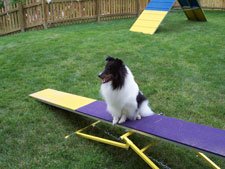
Walk on this
The first step is to encourage your puppy to step on and walk over many different types of surfaces. Use shaping to accomplish this. You may use a slight bit of luring at first, but fade it out very quickly. If you have a clicker-savvy puppy or dog, shaping this type of interaction is a simple process.
The surfaces you ask your dog to walk on should have a variety of textures. For example, a large plastic garbage bag will be slightly slick and may move a bit under your dog's feet. A large pillow will be puffy and springy. A metal cookie sheet will be slippery. Other possibilities are cardboard and plastic lids from large storage containers. Remember to keep safety in mind at all times, as you don't want your pup to scare or hurt himself. You do want him to become confident walking on many different surfaces.
Be sure to reinforce highly for venturing on to the various surfaces. Meat flavored baby food is a good reinforcer! Your goal is not a specific behavior, but all types of movement on the surfaces. You might even reinforce your dog for a "spin," a "down," or a "sit" on the surface.
Add instability

Once your puppy is comfortable walking on all types of surfaces, you need to add some gentle instability so that the surface moves slightly. A small piece of PVC (we often use a jump bar) placed under an object causes some movement. Some dogs, once they realize that an object moves, back off a bit and are hesitant to approach it again. Don't pressure your dog at this point! Pressure will only convince him that there is something to worry about. Instead, offer your highest value food reinforcer for simply approaching the object. Shape him over a number of short sessions to interact with the now moving object.
Place a small piece of PVC under the lid from a large plastic storage container. Let your dog discover that putting a paw on the object pays off. If he causes the object to move, even slightly, give him a huge jackpot! You want to build up a positive association with moving objects. High reinforcement at this point will pay off later on, so don't be stingy.
Round plastic lids from garbage cans, set upside down, also allow your pup an opportunity to make something move. Your ultimate goal should be to get your pup to step inside the lid and actually rock it back and forth a bit. A small laundry basket, turned upside down, is another good object to try. Use a relatively flimsy basket so that it compresses under your dog's weight.
With all of these different possibilities, be sure to click while your dog is actually in contact with the object. Late clicks, clicks that come when your dog is no longer in contact with the object, are not what you want to reinforce.
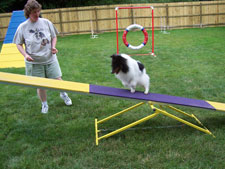
Even more instability
By now, your pup should understand the game of making things move under his feet. Let's up the criteria a bit.
Many agility trainers use a tippy board (also called a Buja board) as a precursor to the teeter. The tippy board is usually a large round or square piece of wood with something to cause movement attached to the middle of the bottom. A small piece of wood or a tennis ball attached to the bottom will do the trick. The tippy board is a great idea, but often many trainers make this the first step, rather than starting with the foundation work outlined above. A dog that is introduced to the tippy board without the foundation is more likely to react negatively to the movement under his feet. The dog with a good foundation is likely to see tipping as another great opportunity to earn reinforcers. Again, the focus should be on reinforcing any interaction with the tippy board.
A skateboard is a great tool to use when teaching a dog to enjoy moving things under his feet. Look for one that is wide, rather than narrow. This will give it more stability. It is a good idea to begin skateboard work on a carpeted surface to limit the amount of rolling at first. If you have done your foundation work up to this point, your dog will be very quick to discover that he can cause the skateboard to move, and that this is the behavior that pays off. Don't expect much at first, perhaps just putting a foot on the board and then pushing it a bit. Eventually, your dog will put two feet on the board and push it a short distance. Skateboard training shows your dog that he can control moving objects under his feet. Once he understands this concept, teeter training will be a piece of cake!

Teeter training
Start with the teeter board on the ground, if possible. Let your dog get used to interacting with the board before you add a brick or piece of PVC under it to introduce movement. Once your dog is comfortable moving the board at a very low height, you can put the board on the teeter base at the lowest possible level. The key is to increase the height of the teeter gradually. It is important to work with an adjustable height teeter and raise it an inch or so per training session. Making big changes in the height of the teeter can lead to caution or fear. We want our dogs to be very, very confident and comfortable on the board.
Don't worry about the "proper" way to do the teeter yet. Don't worry about your contact behavior either. You want your dog jumping on and off the board at both ends and the middle, running up or down the board, turning around on the board, sitting, lying down, and banging the board to the ground with one or both front paws. Reinforce all of these behaviors at each height before raising the board a bit more.
Ready to rock!
If you started movement training with your puppy, he will be ready to learn the teeter by the time he is physically mature. All the foundation work in his first year will pay off with quick and easy learning. Your puppy will see the teeter as a reinforcement opportunity. Plus, many dogs find it just plain fun to race up the teeter and bang it to the ground.
If you are working with an older dog, particularly one that has had unpleasant experiences with the teeter, it may take longer to retrain than to train it right the first time. You have to undo the negative association your dog has made and replace that with a positive association, which can take some time. He now needs to be convinced that he controls the movement of the board and that it is not scary or dangerous. By planning your progressions carefully, and working in very short sessions, you can change your dog's attitude about the teeter. Rather than just tolerating it, he will be "ready to rock!"
Related Products
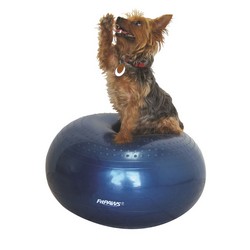 |
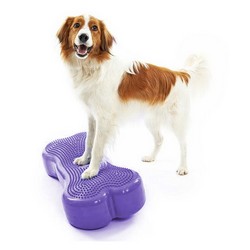 |
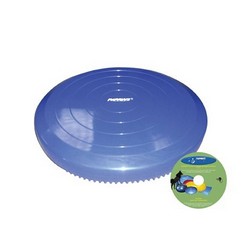 |
| FitPAWS Donut |
K9 FitBone Balance Disc |
FitPAWS Balance Disc |




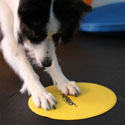
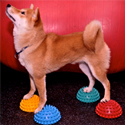
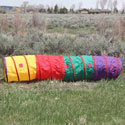

Post new comment